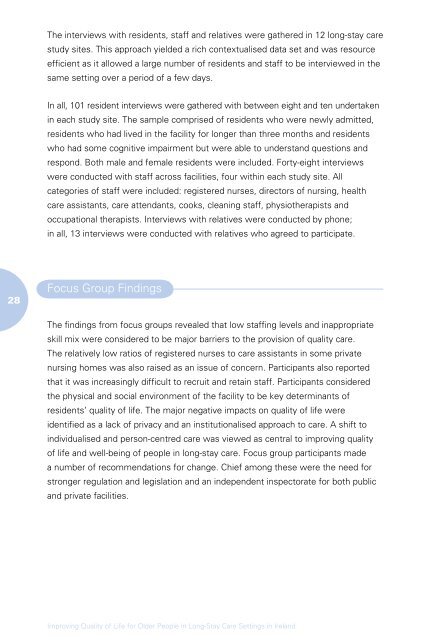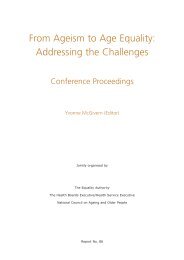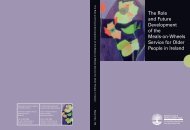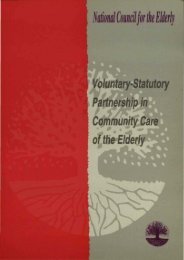Improving Quality of Life for Older People in Long-Stay Care ...
Improving Quality of Life for Older People in Long-Stay Care ...
Improving Quality of Life for Older People in Long-Stay Care ...
- No tags were found...
You also want an ePaper? Increase the reach of your titles
YUMPU automatically turns print PDFs into web optimized ePapers that Google loves.
The <strong>in</strong>terviews with residents, staff and relatives were gathered <strong>in</strong> 12 long-stay carestudy sites. This approach yielded a rich contextualised data set and was resourceefficient as it allowed a large number <strong>of</strong> residents and staff to be <strong>in</strong>terviewed <strong>in</strong> thesame sett<strong>in</strong>g over a period <strong>of</strong> a few days.In all, 101 resident <strong>in</strong>terviews were gathered with between eight and ten undertaken<strong>in</strong> each study site. The sample comprised <strong>of</strong> residents who were newly admitted,residents who had lived <strong>in</strong> the facility <strong>for</strong> longer than three months and residentswho had some cognitive impairment but were able to understand questions andrespond. Both male and female residents were <strong>in</strong>cluded. Forty-eight <strong>in</strong>terviewswere conducted with staff across facilities, four with<strong>in</strong> each study site. Allcategories <strong>of</strong> staff were <strong>in</strong>cluded: registered nurses, directors <strong>of</strong> nurs<strong>in</strong>g, healthcare assistants, care attendants, cooks, clean<strong>in</strong>g staff, physiotherapists andoccupational therapists. Interviews with relatives were conducted by phone;<strong>in</strong> all, 13 <strong>in</strong>terviews were conducted with relatives who agreed to participate.28Focus Group F<strong>in</strong>d<strong>in</strong>gsThe f<strong>in</strong>d<strong>in</strong>gs from focus groups revealed that low staff<strong>in</strong>g levels and <strong>in</strong>appropriateskill mix were considered to be major barriers to the provision <strong>of</strong> quality care.The relatively low ratios <strong>of</strong> registered nurses to care assistants <strong>in</strong> some privatenurs<strong>in</strong>g homes was also raised as an issue <strong>of</strong> concern. Participants also reportedthat it was <strong>in</strong>creas<strong>in</strong>gly difficult to recruit and reta<strong>in</strong> staff. Participants consideredthe physical and social environment <strong>of</strong> the facility to be key determ<strong>in</strong>ants <strong>of</strong>residents’ quality <strong>of</strong> life. The major negative impacts on quality <strong>of</strong> life wereidentified as a lack <strong>of</strong> privacy and an <strong>in</strong>stitutionalised approach to care. A shift to<strong>in</strong>dividualised and person-centred care was viewed as central to improv<strong>in</strong>g quality<strong>of</strong> life and well-be<strong>in</strong>g <strong>of</strong> people <strong>in</strong> long-stay care. Focus group participants madea number <strong>of</strong> recommendations <strong>for</strong> change. Chief among these were the need <strong>for</strong>stronger regulation and legislation and an <strong>in</strong>dependent <strong>in</strong>spectorate <strong>for</strong> both publicand private facilities.<strong>Improv<strong>in</strong>g</strong> <strong>Quality</strong> <strong>of</strong> <strong>Life</strong> <strong>for</strong> <strong>Older</strong> <strong>People</strong> <strong>in</strong> <strong>Long</strong>-<strong>Stay</strong> <strong>Care</strong> Sett<strong>in</strong>gs <strong>in</strong> Ireland















